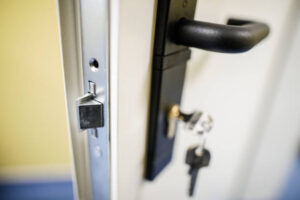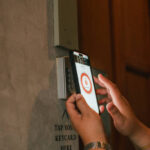Why Professional Installation is Crucial for Maximum Security
When you’re looking at high security door locks, it’s easy to think, “I can handle this myself.” But hold your horses! Even the most enthusiastic DIYer can run into trouble. Here are some common blunders folks make and why getting a pro on board is worth every penny.
1. Misaligning the Lock
Picture this: You’ve spent hours installing that shiny new lock, only to find out it doesn’t line up with the strike plate. Frustrating, right? This happens more often than you’d think. A slight misalignment means your door won’t latch properly, making all that effort go down the drain.
2. Using Inferior Tools
Sure, you might have a toolbox full of gadgets collected over the years, but not all tools are created equal. Trying to install high-security locks with subpar equipment is like bringing a knife to a gunfight—it just won’t cut it (pun intended). Pros come equipped with specialized tools designed specifically for these jobs.
3. Ignoring Manufacturer Instructions
Raise your hand if you’ve ever tossed aside an instruction manual because you thought you knew better! Guilty as charged? Many people skip crucial steps or use incorrect techniques simply because they didn’t read those tiny booklets that came in the box.

4. Incorrect Hole Sizes
Ever tried fitting a square peg in a round hole? That’s what happens when you drill holes too small or too large for your lock hardware. It compromises both functionality and security—two things we definitely don’t want messing around with!
5. Overlooking Deadbolt Depths
The deadbolt needs enough room within the frame to extend fully; otherwise, it’s about as useful as screen doors on submarines! People often forget this step and end up reducing their lock’s effectiveness without even realizing it.
So why bother going through these headaches alone?
Here’s where calling in professionals becomes vital:
They’ve seen everything under the sun—from warped frames causing alignment issues to old houses requiring custom adjustments no one else would think of making offhandedly—and know exactly how best fix them efficiently without compromising safety standards whatsoever (or sanity).
6. Skimping on Reinforcement
Even the best lock won’t do much good if your door frame is as flimsy as a wet noodle. Many DIYers forget to reinforce their door frames, leaving them vulnerable to brute force attacks. Pros know how to fortify these weak points with strike plates and longer screws that dig deep into the wall studs.
7. Failing to Test Properly
Imagine this: You’ve finally installed your high-security lock, but you’re too tired or excited to test it thoroughly. Big mistake! Without proper testing, you might miss issues like jamming or incomplete locking mechanisms. Professionals will rigorously test every aspect of the installation before calling it a day.
8. Neglecting Aesthetic Details
You might think aesthetics are secondary when installing security locks, but mismatched hardware can be an eyesore and even affect resale value down the line. Pros ensure everything looks spick-and-span while still providing top-notch security.
Let’s face it—installing high-security locks isn’t just about following steps; it’s about understanding nuances only experience can teach you. So next time you’re tempted by a weekend project involving complex lock systems, remember: sometimes it’s smarter (and safer) to leave things in expert hands who’ll get it right without breaking a sweat—or your new lock!
Installing High-Security Door Locks and Reinforcing Your Door Frame
When you’re investing in high security door locks, the last thing you want is to botch the installation. These locks are designed to keep intruders out, but if they’re not installed correctly, they might as well be made of tissue paper. One major aspect that often gets overlooked? The door frame reinforcement.
First off, let’s talk about your typical wooden door frame. It’s like putting a state-of-the-art alarm system on a house with no walls. You need something sturdy enough to hold up against forceful entry attempts. Many folks make the mistake of assuming their existing frames will do just fine, but that’s usually not the case.
Picture this: You’ve got an impenetrable lock on your front door, but someone kicks it hard enough and—boom—the whole frame gives way. All that money spent on high-tech security goes down the drain because you didn’t reinforce where it counts.
So what should you do? Metal strike plates are your best friends here. They distribute force more evenly across a larger area than standard plates do. It’s like having bodyguards for your lock; they take some of the impact so your lock doesn’t have to bear all of it alone.
Another common error is using short screws when installing these metal strike plates or even hinges for that matter! Short screws are easy prey—they pop right out under pressure. Opt for long screws instead; think 3-inchers at least! These dig deep into the studs behind your wall and provide much better resistance against brute force attacks.
Here’s another blunder people often commit: neglecting hinge reinforcements altogether! If you’ve only fortified one side (the latch side) and left those flimsy little hinges untouched, you’re basically inviting trouble from behind—a classic backdoor sneak attack scenario!
Now let’s chat about deadbolts because they’re vital too—but only if used properly! A lot of DIY enthusiasts get excited about installing double-cylinder deadbolts without considering local fire codes or practical day-to-day use scenarios (like needing quick exits during emergencies). Double-check regulations before going gung-ho with such installations!
And while we’re discussing deadbolts—don’t forget bolt length matters too! Those cute little half-inch bolts won’t cut it against determined intruders wielding crowbars or other tools meant for prying doors open quickly.
Have I mentioned alignment yet? Because boy oh boy does misalignment mess things up big time! Imagine trying desperately turning keys in poorly aligned locks—it feels almost cartoonish how ineffective everything becomes then doesn’t it?
You end up jiggling the key like you’re trying to start an old lawnmower. And in a high-stress situation, that’s the last thing you need. Always double-check that everything lines up perfectly before calling it a day.
Oh, and don’t forget about weatherstripping! It might seem trivial compared to all this heavy-duty talk, but proper sealing keeps out moisture which can weaken your door frame over time. A little foresight here saves big headaches later.






